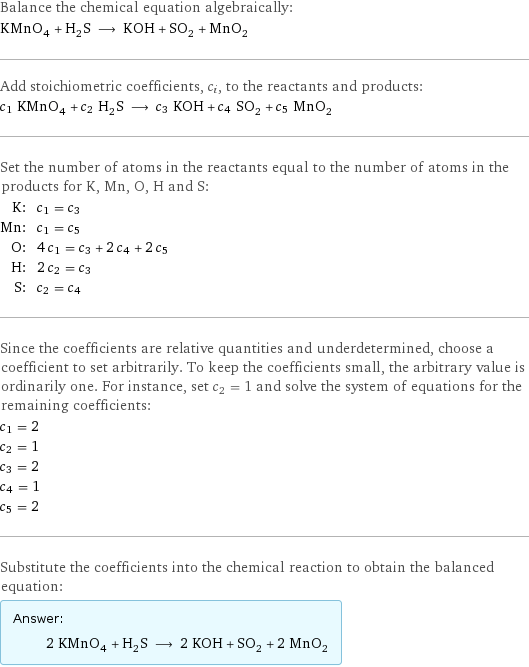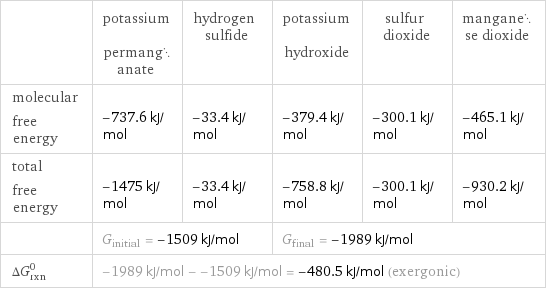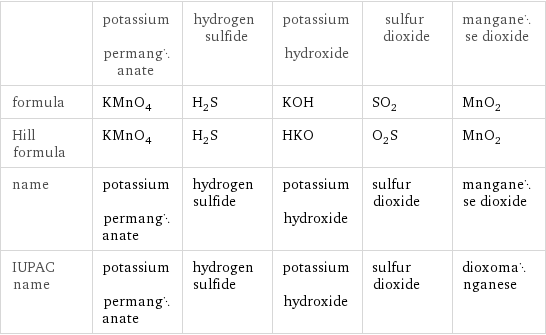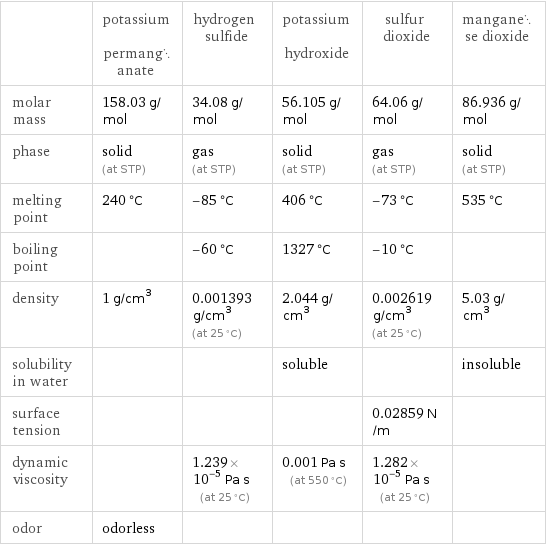Input interpretation

KMnO_4 potassium permanganate + H_2S hydrogen sulfide ⟶ KOH potassium hydroxide + SO_2 sulfur dioxide + MnO_2 manganese dioxide
Balanced equation

Balance the chemical equation algebraically: KMnO_4 + H_2S ⟶ KOH + SO_2 + MnO_2 Add stoichiometric coefficients, c_i, to the reactants and products: c_1 KMnO_4 + c_2 H_2S ⟶ c_3 KOH + c_4 SO_2 + c_5 MnO_2 Set the number of atoms in the reactants equal to the number of atoms in the products for K, Mn, O, H and S: K: | c_1 = c_3 Mn: | c_1 = c_5 O: | 4 c_1 = c_3 + 2 c_4 + 2 c_5 H: | 2 c_2 = c_3 S: | c_2 = c_4 Since the coefficients are relative quantities and underdetermined, choose a coefficient to set arbitrarily. To keep the coefficients small, the arbitrary value is ordinarily one. For instance, set c_2 = 1 and solve the system of equations for the remaining coefficients: c_1 = 2 c_2 = 1 c_3 = 2 c_4 = 1 c_5 = 2 Substitute the coefficients into the chemical reaction to obtain the balanced equation: Answer: | | 2 KMnO_4 + H_2S ⟶ 2 KOH + SO_2 + 2 MnO_2
Structures

+ ⟶ + +
Names

potassium permanganate + hydrogen sulfide ⟶ potassium hydroxide + sulfur dioxide + manganese dioxide
Reaction thermodynamics
Gibbs free energy

| potassium permanganate | hydrogen sulfide | potassium hydroxide | sulfur dioxide | manganese dioxide molecular free energy | -737.6 kJ/mol | -33.4 kJ/mol | -379.4 kJ/mol | -300.1 kJ/mol | -465.1 kJ/mol total free energy | -1475 kJ/mol | -33.4 kJ/mol | -758.8 kJ/mol | -300.1 kJ/mol | -930.2 kJ/mol | G_initial = -1509 kJ/mol | | G_final = -1989 kJ/mol | | ΔG_rxn^0 | -1989 kJ/mol - -1509 kJ/mol = -480.5 kJ/mol (exergonic) | | | |
Equilibrium constant
![Construct the equilibrium constant, K, expression for: KMnO_4 + H_2S ⟶ KOH + SO_2 + MnO_2 Plan: • Balance the chemical equation. • Determine the stoichiometric numbers. • Assemble the activity expression for each chemical species. • Use the activity expressions to build the equilibrium constant expression. Write the balanced chemical equation: 2 KMnO_4 + H_2S ⟶ 2 KOH + SO_2 + 2 MnO_2 Assign stoichiometric numbers, ν_i, using the stoichiometric coefficients, c_i, from the balanced chemical equation in the following manner: ν_i = -c_i for reactants and ν_i = c_i for products: chemical species | c_i | ν_i KMnO_4 | 2 | -2 H_2S | 1 | -1 KOH | 2 | 2 SO_2 | 1 | 1 MnO_2 | 2 | 2 Assemble the activity expressions accounting for the state of matter and ν_i: chemical species | c_i | ν_i | activity expression KMnO_4 | 2 | -2 | ([KMnO4])^(-2) H_2S | 1 | -1 | ([H2S])^(-1) KOH | 2 | 2 | ([KOH])^2 SO_2 | 1 | 1 | [SO2] MnO_2 | 2 | 2 | ([MnO2])^2 The equilibrium constant symbol in the concentration basis is: K_c Mulitply the activity expressions to arrive at the K_c expression: Answer: | | K_c = ([KMnO4])^(-2) ([H2S])^(-1) ([KOH])^2 [SO2] ([MnO2])^2 = (([KOH])^2 [SO2] ([MnO2])^2)/(([KMnO4])^2 [H2S])](../image_source/c85d09c766ddc519dec7931267ebfd99.png)
Construct the equilibrium constant, K, expression for: KMnO_4 + H_2S ⟶ KOH + SO_2 + MnO_2 Plan: • Balance the chemical equation. • Determine the stoichiometric numbers. • Assemble the activity expression for each chemical species. • Use the activity expressions to build the equilibrium constant expression. Write the balanced chemical equation: 2 KMnO_4 + H_2S ⟶ 2 KOH + SO_2 + 2 MnO_2 Assign stoichiometric numbers, ν_i, using the stoichiometric coefficients, c_i, from the balanced chemical equation in the following manner: ν_i = -c_i for reactants and ν_i = c_i for products: chemical species | c_i | ν_i KMnO_4 | 2 | -2 H_2S | 1 | -1 KOH | 2 | 2 SO_2 | 1 | 1 MnO_2 | 2 | 2 Assemble the activity expressions accounting for the state of matter and ν_i: chemical species | c_i | ν_i | activity expression KMnO_4 | 2 | -2 | ([KMnO4])^(-2) H_2S | 1 | -1 | ([H2S])^(-1) KOH | 2 | 2 | ([KOH])^2 SO_2 | 1 | 1 | [SO2] MnO_2 | 2 | 2 | ([MnO2])^2 The equilibrium constant symbol in the concentration basis is: K_c Mulitply the activity expressions to arrive at the K_c expression: Answer: | | K_c = ([KMnO4])^(-2) ([H2S])^(-1) ([KOH])^2 [SO2] ([MnO2])^2 = (([KOH])^2 [SO2] ([MnO2])^2)/(([KMnO4])^2 [H2S])
Rate of reaction
![Construct the rate of reaction expression for: KMnO_4 + H_2S ⟶ KOH + SO_2 + MnO_2 Plan: • Balance the chemical equation. • Determine the stoichiometric numbers. • Assemble the rate term for each chemical species. • Write the rate of reaction expression. Write the balanced chemical equation: 2 KMnO_4 + H_2S ⟶ 2 KOH + SO_2 + 2 MnO_2 Assign stoichiometric numbers, ν_i, using the stoichiometric coefficients, c_i, from the balanced chemical equation in the following manner: ν_i = -c_i for reactants and ν_i = c_i for products: chemical species | c_i | ν_i KMnO_4 | 2 | -2 H_2S | 1 | -1 KOH | 2 | 2 SO_2 | 1 | 1 MnO_2 | 2 | 2 The rate term for each chemical species, B_i, is 1/ν_i(Δ[B_i])/(Δt) where [B_i] is the amount concentration and t is time: chemical species | c_i | ν_i | rate term KMnO_4 | 2 | -2 | -1/2 (Δ[KMnO4])/(Δt) H_2S | 1 | -1 | -(Δ[H2S])/(Δt) KOH | 2 | 2 | 1/2 (Δ[KOH])/(Δt) SO_2 | 1 | 1 | (Δ[SO2])/(Δt) MnO_2 | 2 | 2 | 1/2 (Δ[MnO2])/(Δt) (for infinitesimal rate of change, replace Δ with d) Set the rate terms equal to each other to arrive at the rate expression: Answer: | | rate = -1/2 (Δ[KMnO4])/(Δt) = -(Δ[H2S])/(Δt) = 1/2 (Δ[KOH])/(Δt) = (Δ[SO2])/(Δt) = 1/2 (Δ[MnO2])/(Δt) (assuming constant volume and no accumulation of intermediates or side products)](../image_source/0d974d364b8686fb05bb5a47ceaee470.png)
Construct the rate of reaction expression for: KMnO_4 + H_2S ⟶ KOH + SO_2 + MnO_2 Plan: • Balance the chemical equation. • Determine the stoichiometric numbers. • Assemble the rate term for each chemical species. • Write the rate of reaction expression. Write the balanced chemical equation: 2 KMnO_4 + H_2S ⟶ 2 KOH + SO_2 + 2 MnO_2 Assign stoichiometric numbers, ν_i, using the stoichiometric coefficients, c_i, from the balanced chemical equation in the following manner: ν_i = -c_i for reactants and ν_i = c_i for products: chemical species | c_i | ν_i KMnO_4 | 2 | -2 H_2S | 1 | -1 KOH | 2 | 2 SO_2 | 1 | 1 MnO_2 | 2 | 2 The rate term for each chemical species, B_i, is 1/ν_i(Δ[B_i])/(Δt) where [B_i] is the amount concentration and t is time: chemical species | c_i | ν_i | rate term KMnO_4 | 2 | -2 | -1/2 (Δ[KMnO4])/(Δt) H_2S | 1 | -1 | -(Δ[H2S])/(Δt) KOH | 2 | 2 | 1/2 (Δ[KOH])/(Δt) SO_2 | 1 | 1 | (Δ[SO2])/(Δt) MnO_2 | 2 | 2 | 1/2 (Δ[MnO2])/(Δt) (for infinitesimal rate of change, replace Δ with d) Set the rate terms equal to each other to arrive at the rate expression: Answer: | | rate = -1/2 (Δ[KMnO4])/(Δt) = -(Δ[H2S])/(Δt) = 1/2 (Δ[KOH])/(Δt) = (Δ[SO2])/(Δt) = 1/2 (Δ[MnO2])/(Δt) (assuming constant volume and no accumulation of intermediates or side products)
Chemical names and formulas

| potassium permanganate | hydrogen sulfide | potassium hydroxide | sulfur dioxide | manganese dioxide formula | KMnO_4 | H_2S | KOH | SO_2 | MnO_2 Hill formula | KMnO_4 | H_2S | HKO | O_2S | MnO_2 name | potassium permanganate | hydrogen sulfide | potassium hydroxide | sulfur dioxide | manganese dioxide IUPAC name | potassium permanganate | hydrogen sulfide | potassium hydroxide | sulfur dioxide | dioxomanganese
Substance properties

| potassium permanganate | hydrogen sulfide | potassium hydroxide | sulfur dioxide | manganese dioxide molar mass | 158.03 g/mol | 34.08 g/mol | 56.105 g/mol | 64.06 g/mol | 86.936 g/mol phase | solid (at STP) | gas (at STP) | solid (at STP) | gas (at STP) | solid (at STP) melting point | 240 °C | -85 °C | 406 °C | -73 °C | 535 °C boiling point | | -60 °C | 1327 °C | -10 °C | density | 1 g/cm^3 | 0.001393 g/cm^3 (at 25 °C) | 2.044 g/cm^3 | 0.002619 g/cm^3 (at 25 °C) | 5.03 g/cm^3 solubility in water | | | soluble | | insoluble surface tension | | | | 0.02859 N/m | dynamic viscosity | | 1.239×10^-5 Pa s (at 25 °C) | 0.001 Pa s (at 550 °C) | 1.282×10^-5 Pa s (at 25 °C) | odor | odorless | | | |
Units
